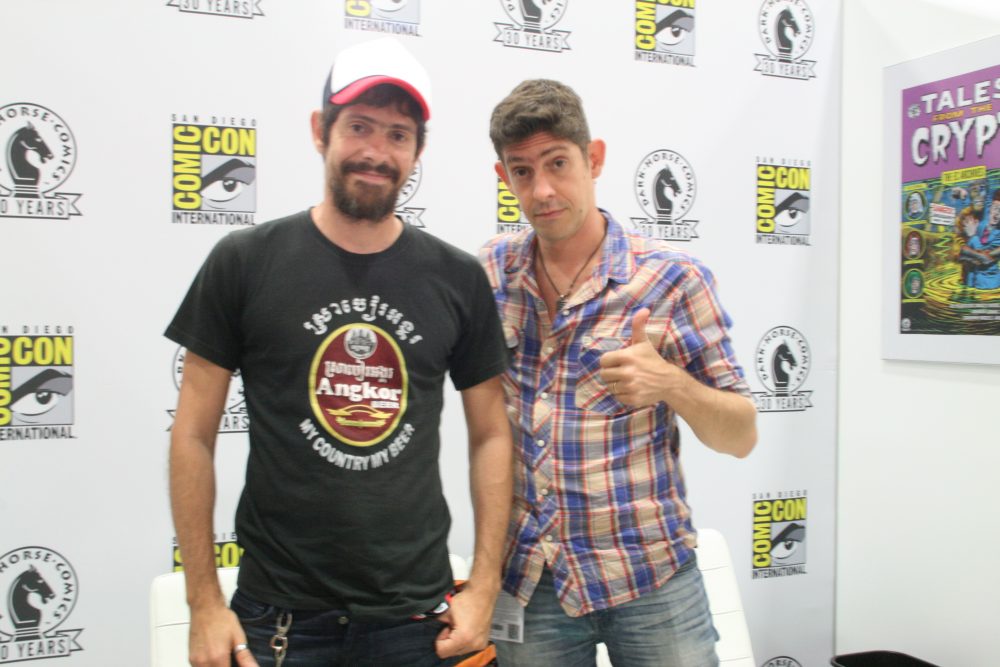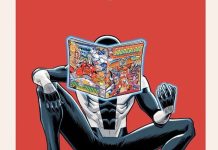By Donald Powell
Eisner Award-winning writers and artists Fabio Moon and Gabriel Ba took time out from their busy schedule to talk about the evolution of their careers and the impact Comic Con continues to have in their lives. They have been nominated for this year’s Eisner Awards for their work on Two Brothers.
Donald Powell: In your blog, you talked about when you came to Comic Con in 2006, your careers were starting to take off, and now it’s completely different. How has your career changed since then, and how has the Comic Con changed?
Fabio Moon: We’ve been coming to San Diego since 1997 every year, so we saw the whole thing change, as well as the perception of the convention and of the market. It’s very easy to lose track of what’s changed and how it was before. Before that we complained about the video games; they took almost no space in the convention center [compared to] the panels. After Hollywood came, their booths were huge, their panels brought huge crowds, so it’s a lot more people. We saw the whole convention center expansion, which was one-third of the space it is now. You could walk the whole floor in proportion to this whole press where we are today.
Gabriel Ba: At the same time, because we’ve been coming for 20 years, we still see the value of how San Diego Comic Con is important for comics. It’s still the only convention in the U.S. where you could see all the publishers; the indie publishers, the big mainstream publishers, everyone. The audience for all those types of comics only come here. We don’t get that if we go to New York Comic Con, and we don’t get that if we go to the smaller, more indie-oriented comic cons. If you can survive all these people walking around for the entertainment is to have all these people love comics who come every year. We were able to realize that San Diego is still very special and we’re discovering all this stuff, all this opportunity that people from all over the world come to still experience.
Two Brothers is an adaptation of a Brazilian novel, and you guys just adapted Neil Gaiman’s “How to Talk to Girls at Parties.” How is adapting a novel different from working on your own scripts and stories?
FM: It’s harder, for starters.
GB: Because we have to love the source material to do the adaptation and make those stories into great comics.
A lot of people have not read the original – especially the Brazilian novel – even though it’s been published here in English. We’ve been realizing that a lot of people haven’t read the short stories of Neil Gaiman also. For a lot of people, it’s an original book. We have to make it feel like an original and bring out the qualities that only comics can do, to enhance what we love about the original.
We never thought we would do adaptations because we wanted to create original stuff. But if they are stories that we love, we think they are worth retelling. It comes back to the oral traditions that we like and that we have to tell to other people – you pass around this passion. That’s how we approach adaptations because otherwise it’s so much harder.
FM: It’s a different way of doing or approaching a story because you have to choose what you are going to cut off [since] the story is already there. We need to have to have a complete overall idea so we know where we are going. So we know what’s going to happen, but then we have to create our way to get there.
GB: In an adaptation, you have to learn how to transform the words into images and make them work as images the same way they worked as sentences.
You guys are brothers famous for collaborating with each other. What’s the difference with the work you do with each other versus the work you do with Matt Fraction or Gerard Way, for example?
GB: We exercise a different muscle of our creativity working with someone else’s script because they have different ideas, and different images in their writing. We have to leave our comfort zone to try to make those images real for the page. Ever since we started working with other writers we became better artists, and we have learned new ways of storytelling, of dialogue, putting together dialogue. The stories we do are few and far between, so they are very special and carefully chosen. We usually use very little dialogue in our own stories. The writing, the pace was slow.
FM: Working with Matt made our pages denser, and working with Gerard made our pages more dynamic. It made Ba know how to work with craziness and make it make sense, because the ideas are very crazy but they are specific visually. And Mignola has a very visual script, so those scripts made us realize, “That’s how these authors are writing for other artists and still giving us the liberty to choose images.”
But from every writer we work with; we learn. When you have the writer and artist in front of the reader, you have to make it look like one thing. There’s the creator, there’s the comic book and there’s the reader—but it has to look like they are agreeing and making sense, and that the experience is fluid for everyone. For us it was very easy to have this fluid quality. When we work with other artists it becomes more of a challenge—to make it look like one mind telling one story.
Finally, if you were stranded on a desert island and you could take one comic creator’s work with you, whose would it be?
GB: Lone Wolf and Cub.
FM: Oh yeah, that’s a good one!
GB: It covers lots of ground. It does everything we think comics should do in terms of stories that can be complex, have several layers and talk about stuff that makes readers reflect is something.







